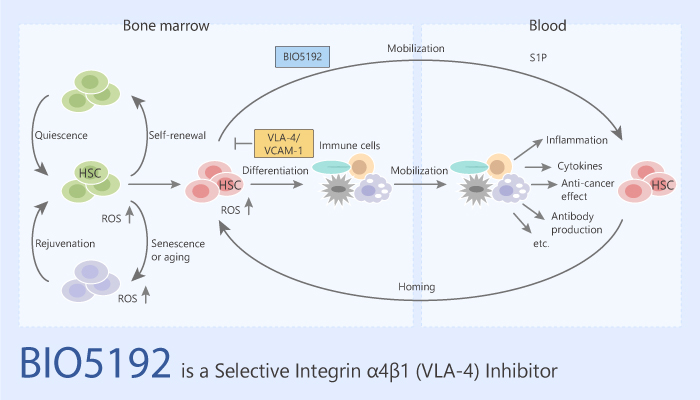Hematopoietic stem and progenitor cells (HSPCs) reside means a specialized microenvironment, which regulates self-renewal and differentiation of HSPCs. Hematopoiesis in the adult mouse often exists in spleen and bone marrow. AS a result, the trafficking of HSPCs between the bone marrow and peripheral blood is a dynamic process.
HSPCs can engraft in the marrow and spleen to restore normal hematopoiesis. In addition, mobilization and homing of HSPC relate to the following two processes. one involves the α4β1 integrin, VLA-4, and its ligand VCAM-1, Additionally, the other chemokine receptor CXCR4 and its ligand SDF-1.
In this article, we will introduce a small molecule inhibitor of VLA-4, BIO5192. It has effects on the mobilization of HSPCs.

BIO5192 is a selective and potent integrin α4β1 (VLA-4) inhibitor (Kd<10 pM). At the same time, it selectively binds to α4β1 (IC50=1.8 μM) over a range of other integrins. Besides, BIO5192 results in a 30-fold increase in mobilization of murine hematopoietic stem and progenitors (HSPCs) over basal levels
In C57BL/6J x 129Sv/J F1 mice, BIO5192 shows the terminal half-life is 1.1 h by intravenous injection. when the dosage is 3, 10, and 30 mg/kg, It shows half-lives of 1.7, 2.7, and 4.7 h, respectively by subcutaneous injection. The blood plasma curves show that the AUC for the s.c. route increases about 2.5-fold. The AUC increases from 5,460 h*ng/ml for the 3 mg/kg dose to 14,175 h*ng/ml for the 30 mg/kg. When BIO5192 combines with Plerixafor, this combination exerts an additive effect on progenitor mobilization.
In healthy female Lewis rats, BIO5192 delays paralysis associated with EAE (experimental autoimmune encephalomyelitis). It shows a 3-day delay in the onset of paralysis.
From all the above, BIO5192, as a selective VLA-4 inhibitor, it exhibits a more rapid and reversible mobilization in HSPC mobilization. In addition, its combination with the CXCR4 inhibitor not only avoid potential toxicities of G-CSF but also save time and resources during a G-CSF–based mobilization.
In conclusion, BIO5192 is a promising agent for the study of the mobilization of HSPCs.
Reference:
Ramirez P, et al. Blood. 2009;114(7):1340‐1343.